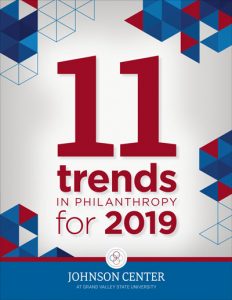As Donors and as Causes, Women are Taking the Lead in Philanthropy


In this piece from our 11 Trends in Philanthropy for 2019 report, Kate Pew Wolters highlights how the movement behind efforts like these has been in the works for decades, and is only now beginning to get the attention it deserves.
 Women have dominated staffing numbers in foundations and nonprofits for decades, and today, the number of women who are taking on roles as institutional leaders and major donors is on the rise. Yet the international spotlight that seems to be falling on women and girls’ causes around the world should be understood more as a blossoming of what’s been happening within philanthropy for generations, than as a wholly new trend.
Women have dominated staffing numbers in foundations and nonprofits for decades, and today, the number of women who are taking on roles as institutional leaders and major donors is on the rise. Yet the international spotlight that seems to be falling on women and girls’ causes around the world should be understood more as a blossoming of what’s been happening within philanthropy for generations, than as a wholly new trend.
As the W.K. Kellogg Foundation’s 2016 report Women’s Philanthropy points out, much of this growth in philanthropic power derives from the simple fact that more and more women have their own money to spend. Women are gaining higher-paid professional positions and finding success as entrepreneurs. They also stand to be the primary beneficiaries of the $59 trillion wealth transfer that has already begun within U.S. family philanthropy (Chiu, 2018). With greater financial heft behind them, these women and others are making choices that often put (or keep) women at the center of their giving.
Philanthropy’s focus on women and girls has been increasing dramatically since the women’s equity movement began in the 1970s, nearly five decades ago, and that focus has steadily translated into giving ever since. In 2016, the W.K. Kellogg Foundation identified international giving from 62 different funders in this arena, totaling $62.7 million; $52.6 million of which was given in the United States.
“Philanthropy’s focus on women and girls has been increasing dramatically since the women’s equity movement began in the 1970s, nearly five decades ago, and that focus has steadily translated into giving ever since.”
That said, social change movements like #MeToo and today’s political climate are drawing more attention from individual and institutional donors alike. The TIME’S UP Legal Defense Fund, launched by a group of women philanthropists in January 2018 to support women coming forward with #MeToo claims, is a prime example: donors have already pledged over $22 million to this cause.
On the high end, Women Moving Millions, an international group of donors at the $1 million and above level, is an example of how women’s long-term leadership in philanthropy is bearing fruit. Founded in 2007 by the Hunt sisters, Helen and Swanee, Women Moving Millions continues to challenge philanthropy to raise the bar on giving to women and girls. As a result of their efforts, more than 300 members have pledged over $650 million in donations to women-focused causes and organizations globally.
Women have also been the earliest and most eager adopters of the giving circles model — dating back to the 1980s (Bearman, 2017). Often described as “the democratization of philanthropy,” giving circles and other collective giving groups continue to give many women and first-time philanthropists a seat at the table and an intimate view of the giving process. Giving circles owe their popularity today in large part to the efforts of thousands of women who have used this model to maximize the impact of their giving and their collaboration (Bearman, 2017).
Grantmaking to projects and programs affecting women and girls, like most things, reflects the changing nature of our times. Today, we see grants around empowerment for women and girls, access to health care, wage equity, and advocacy, and it is quite likely that giving to support gender equity will continue to increase. With women leading 44 percent of the top 25 largest foundations, these voices will most certainly be heard loud and clear.
In the end, women as leaders, as funders, and as advocates will continue to change the landscape of the philanthropic community in the near future and in decades to come. But the movement we are seeing in this space today is truly the outcome of decades of women’s leadership in philanthropy, not merely a sudden phenomenon brought about by political and cultural change. The proof — and perhaps natural progression — of their effectiveness will be in increased economic self-sufficiency for women, improved health and health access, and more women in elected positions.

Bearman, J. C. (2017). The landscape of giving circles/collective giving groups in the U.S. Grand Rapids, MI: Collective Giving Research Group. Retrieved from https://johnsoncenter.org/resource/the-landscape-of-giving-circles-collective-giving-groups-in-the-u-s/
Chiu, B. (2018, July 25). The rise of female philanthropists — and three big bets they make. Forbes. Retrieved from https://www.forbes.com/sites/bonniechiu/2018/07/25/the-rise-of-female-philanthropists-and-three-big-bets-they-make/#112f84be5f89
TIME’S UP Legal Defense Fund. (2017, December 20). GoFundMe. Retrieved from https://www.gofundme.com/timesup
W.K. Kellogg Foundation. (2016). Women’s philanthropy: An opportunity for philanthropy and communities.Retrieved from https://www.wkkf.org/~/media/68B80C1B96B341F390777A969A96E5FB.ashx
Women Moving Millions. (n.d.). Stories of Impact. Retrieved from https://womenmovingmillions.org/stories/